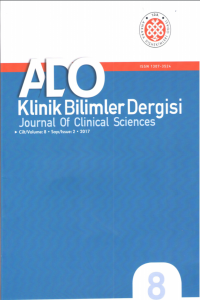Ağız Tabanına Perforasyon Gösteren Dev Tükürük Bezi Taşı
Tükürük bezi taşı, tükürük bezi hastalıkları, ağız kuruluğu
Giant Sialolithiasis Perforated to the Floor of the Mouth
Salivary gland calculi, salivary gland diseases, xerostomia,
___
- Hong KH, Yang YS. Sialolithiasis in the sublingual gland. J Laryngol Otol. 2003;117:905-7.
- Seifert G, Miehlke A, Haubrich J, Chilla R. Diseases of the Salivary Glands: Pathology, Diagnosis, Treatment, Facial Nerve Surgery. 1st ed. New York: Georg Thieme Verlag; 1986. p.63-108,171-281.
- Cummings CW. Cummings Otolaringoloji-Baş ve Boyun Cerrahisi. (Koç C., Çev.), Bölüm 56, Tükrük Bezlerinin Fizyolojisi. 4. baskı. İstanbul: Güneş Tıp Kitabevleri, 2007. s.1307.
- Capaccio P, Torretta S, Ottavian F, Sambataro G, Pignataro L. Modern management of obstructive salivary diseases. Acta Otorhinolaryngol Ital. 2007;27:161 72.
- Bodner L. Giant salivary gland calculi: Diagnostic imaging and surgical management. Oral Surg Oral Med Oral Pathol Oral Radiol Endod. 2002;94:320-3.
- Williams MF. Sialolithiasis. Otolaryngol Clin North Am. 1999;32:819-34.
- Siddiqui SJ. Sialolithiasis: An unusually large submandibular salivary stone. Br Dent J. 2002;193:89-91.
- Austin T, Davis J, Chan T. Sialolithiasis of submandibular gland. J Emerg Med. 2004;26:221-3.
- Drage NA, Brown JE, Makdissi J, Townend J. Migrating salivary stones: Report of three cases. Br J Oral and Maxillofac Surg. 2005;43:180-2.
- Steiner M, Gould AR, Kushner GM, Weber R, Pesto A. Sialolithiasis of the submandibular gland in an 8-year-old child. Oral Surg Oral Med Oral Pathol Oral Radiol Endod. 1997;83:188.
- Azaz B, Regev E, Casap N, Chicin R. Sialolithectomy done with a CO2 laser: Clinical and scintigraphic results. J Oral Maxillofac Surg. 1996;54:685-8.
- Paul D, Chauhan SR. Salivary megalith with a sialo-cutaneous and sialo-oral fistula: A case report. J Laryngol Otol. 1995;109:767-9.
- Iqbal A, Gupta AK, Natu SS, Gupta AK. Unusually large sialolith of Wharton’s duct. Ann Maxillofac Surg. 2012;2:70-3.
- Leung AK, Choi MC, Wagner GA. Multiple sialoliths and a sialolith of unusual size in the submandibular duct: A case report. Oral Surg Oral Med Oral Pathol Oral Radiol Endod. 1999;87:331-3.
- Eun GY, Chung DH, Kwon KH. Advantages of intraoral removal over submandibular gland resection for proximal submandibular stones: A prospective randomized study. Laryngoscope. 2010;120:2189-92.
- Yaman F, Ünlü G, Atılgan S. Ağız içine sürmüş submandibular sialolitiazis: (Olgu sunumu). Atatürk Üniv Diş Hek Fak Derg. 2006;16:70-3.
- ISSN: 1307-3540
- Yayın Aralığı: Yılda 3 Sayı
- Başlangıç: 2006
- Yayıncı: Ankara Diş Hekimleri Odası
Rezin Esaslı Anterior Lamina Venerler ve Güncel Yapım Yöntemleri
Mustafa DÜZYOL, Esra DÜZYOL, Nilgün AKGÜL, Nilgün SEVEN
Şiddetli Diş Aşınması Olan Bir Hastada Multidisipliner Yaklaşım
Hasan Hüseyin KOCAAĞAOĞLU, Akın Erdem YAĞAN, Melike ÖNEL KOLAY, Taha Yaşar MANAV
Elastomerik Ölçü Materyallerinde Güncel Gelişmeler
Betül KÖKDOĞAN BOYACI, Mustafa KOCACIKLI
Maksillofasiyal Travmalarda İlk Müdahale ve Radyografik Görüntüleme
Alime OKKESİM, Barış YILMAZ, Selmi YILMAZ
Ağız Tabanına Perforasyon Gösteren Dev Tükürük Bezi Taşı
Alper AKTAŞ, Duygu UÇAR, Selen ADİLOĞLU
Maksiller Sinüsün Malign Tümörü
Hümeyra Özge YILANCI, Selin ERGÜN, Ali VERAL
Kübra TİTİRİNLİ, Fatma ŞENSES KUŞKAYA, İsmail Doruk KOÇYİĞİT, M Ercüment ÖNDER, Fethi ATIL, Umut TEKİN
